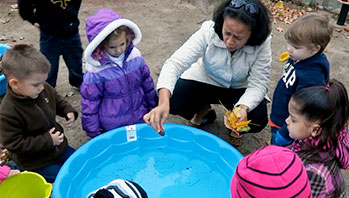- clipboard
- marker
- paper
- transparent color sheets (paddles, sheets of colored acetate, orcolored plastic dividers for notebooks) (red, blue, yellow)
- change
- color
- transparent
MA Standards:
Speaking and Listening/SL.PK.MA.1: Participate in collaborative conversations with diverse partners during daily routines and play.
Language/L.PK.MA.1: Demonstrate use of oral language in informal everyday activities.
MA Draft STE Standards:
Physical Sciences: Matter and Its Interactions: Structure and Properties of Matter: PS1.A: Describe, compare, sort and classify objects based on observable physical characteristics, uses, and whether it is manufactured as part of their classroom play and investigations of the natural and human-made world.
Head Start Outcomes:
Science Knowledge/Conceptual Knowledge of Natural and Physical Worlds: Observes, describes, and discusses living things and natural processes.
Science Knowledge/Scientific Skills and Method: Collects, describes, and records information through discussions, drawings, maps, and charts.
PreK Learning Guidelines:
Science and Technology/Inquiry Skills 3: Identify and use simple tools appropriately to extend observations.
English Language Arts/Language 2: Participate actively in discussions, listen to the ideas of others, and ask and answer relevant questions.
Science and Technology/Living Things and Their Environment 15: Use their senses of sight, hearing, touch, smell, and taste to explore their environment using sensory vocabulary.
Explore Together (outdoors): Colored Lenses

© Commonwealth of Massachusetts, Department of Early Education and Care. All rights reserved.
STEM Key Concepts: There are many different colors; A color can have many different shades (from very light to very dark); Two or more colors can be combined to make a new color
ELA Focus Skills: Follow Directions, Speaking and Listening, Vocabulary
Safety Tips:
- Be aware of and check areas for poison ivy, poison sumac, and bushes with thorns before taking children outside.
- Remind children to wash their hands before and after the activity.
Children’s allergies need to be taken into account before going outside.
Take children outside and give them blue, red, and yellow color paddles and/or colored acetate. Explain that the paddles are made of transparent materials. Say, When a material is transparent it means you can look through it and see what’s on the other side.
- Hold up a green leaf and ask, What do you think will happen when we look at this green leaf through this red paddle? Invite children to look at the leaf and discuss their findings.
Then have children look at different objects around them through the colored transparent materials. Encourage them to dictate or record their observations on the clipboard sheets, or use a camera for documenting observations. As children explore, circulate and engage them with questions such as,
- How do the <dandelions> look different when you look at them through the colored paddle?
- Does the color change? How does the color change?
Gather children together again and hold the colored paddle close to the ground so sunlight can shine through it. Say, I’m going to hold my hand under the colored disc. Watch as the light passes through the disc and onto my hand. Ask,
- What happens to the light after it goes through the colored disc?
- Does my hand look the same or different when I hold it in the light under the blue paddle? Describe how it is the same or different.
- What do you think will happen if I look through a blue paddle and a yellow paddle at the same time?
Have children continue to explore using the color paddles. Encourage them to work together and to draw to record their idea. Continue to document observations by taking photos or videos of children's explorations.
Reflect and Share Together
Once inside, invite children to share what they learned during their explorations. Have colored acetate and paddles available so children can demonstrate what they did and what they observed. Use the notes and photographs to share examples of children's explorations to spark further conversation. Ask questions such as:
- What did you notice when you looked through the different colored discs?
- How did things look different? Why do you think they looked different?
Take It Further: Invite children to use scraps of colored cellophane to make collages. Have children stick the scraps onto a piece of clear contact paper, noting the color changes where two colors overlap. When the artwork is complete, help children put another piece of clear contact paper on top, sandwiching the cellophane-art between the two layers. Hang the art in a window where colorful light can shine through.
Adaptation: If younger children have trouble making the cellophane overlap in their collages, help them place the cellophane and tack it down with a bit of double-stick transparent tape.
Adaptation: Adapt the procedures if younger children will be working in a group. You might prefer to have each child do the activity individually, with one-to-one supervision.
